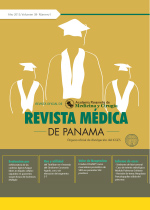Diagnósticos en el Cáncer de Pulmón de Células No Pequeñas (CPCNP) y Clasificación TNM (CPCNP): 2do Consenso Nacional de la Sociedad Panameña de Oncología (SPO). (Mesa 2)
Autores/as
DOI:
https://doi.org/10.37980/im.journal.rmdp.2017428Resumen
Resumen
En todo paciente con sospecha de cáncer de pulmón la obtención de tejido para su análisis patológico es de vital importancia previo al inicio de cualquier tratamiento. Sin embargo, en muchas ocasiones la obtención de tejido se puede convertir en un verdadero reto ya que las lesiones no siempre son accesibles por broncoscopia y la tasas de complicaciones de la biopsia percutánea guiada por Tomografía pueden llegar hasta el 15 % en ciertas poblaciones de alto riesgo (adultos mayores, fumadores y con enfermedad pulmonar obstructiva crónica)[1].
El objetivo de este consenso es orientar al personal de salud sobre los pasos a seguir para el diagnóstico oportuno del nódulo pulmonar solitario y la enfermedad con características francas de malignidad (Localmente avanzada y metastásica) para su pronta referencia al grupo de Manejo Multidisciplinario.
[Diagnostic Studies in Non Small Cell Lung Cancer (NSCLC) and TNM Classification (CPCNP): 2nd National Consensus of the Panamanian Oncology Society (SPO)]
Abstract
In all patients with suspected lung cancer, obtaining tissue for pathological analysis is of vital importance prior to the initiation of any treatment. However, tissue procurement can often become a real challenge since the lesions are not always accessible by bronchoscopy and the complication rates of CT-guided percutaneous biopsy can reach up to 15% in certain high-risk populations risk (elderly, smokers and with chronic obstructive pulmonary disease)[1].
The objective of this consensus is to guide health personnel on the steps to follow for the timely diagnosis of the solitary pulmonary nodule and the disease with frank characteristics of malignancy (Locally advanced and metastatic) for its early reference to the Multidisciplinary Management group.
Publicado
Número
Sección
Licencia
Derechos autoriales y de reproducibilidad. La Revista Médica de Panama es un ente académico, sin fines de lucro, que forma parte de la Academia Panameña de Medicina y Cirugía. Sus publicaciones son de tipo acceso gratuito de su contenido para uso individual y académico, sin restricción. Los derechos autoriales de cada artículo son retenidos por sus autores. Al Publicar en la Revista, el autor otorga Licencia permanente, exclusiva, e irrevocable a la Sociedad para la edición del manuscrito, y otorga a la empresa editorial, Infomedic International Licencia de uso de distribución, indexación y comercial exclusiva, permanente e irrevocable de su contenido y para la generación de productos y servicios derivados del mismo. En caso que el autor obtenga la licencia CC BY, el artículo y sus derivados son de libre acceso y distribución.






